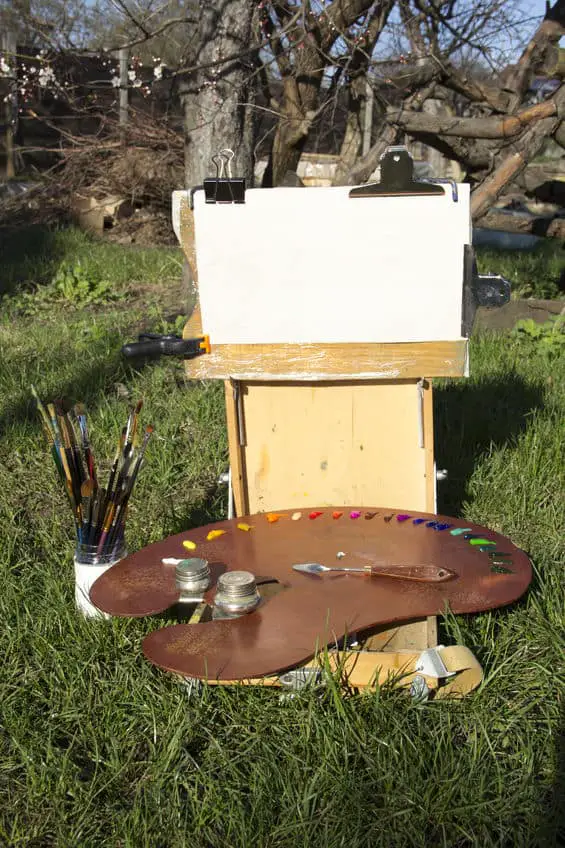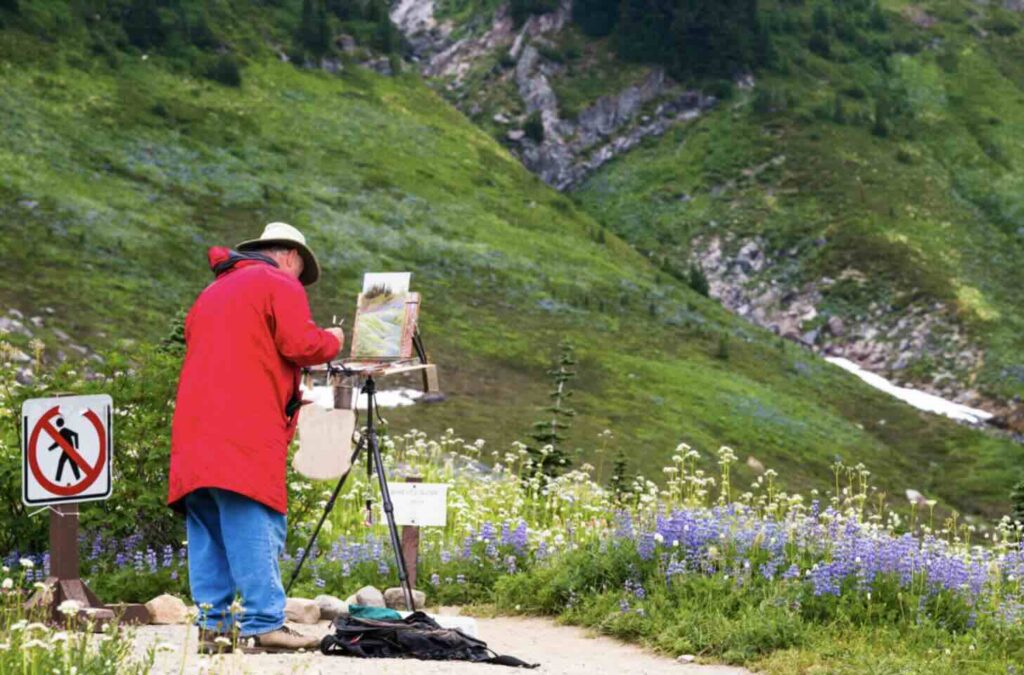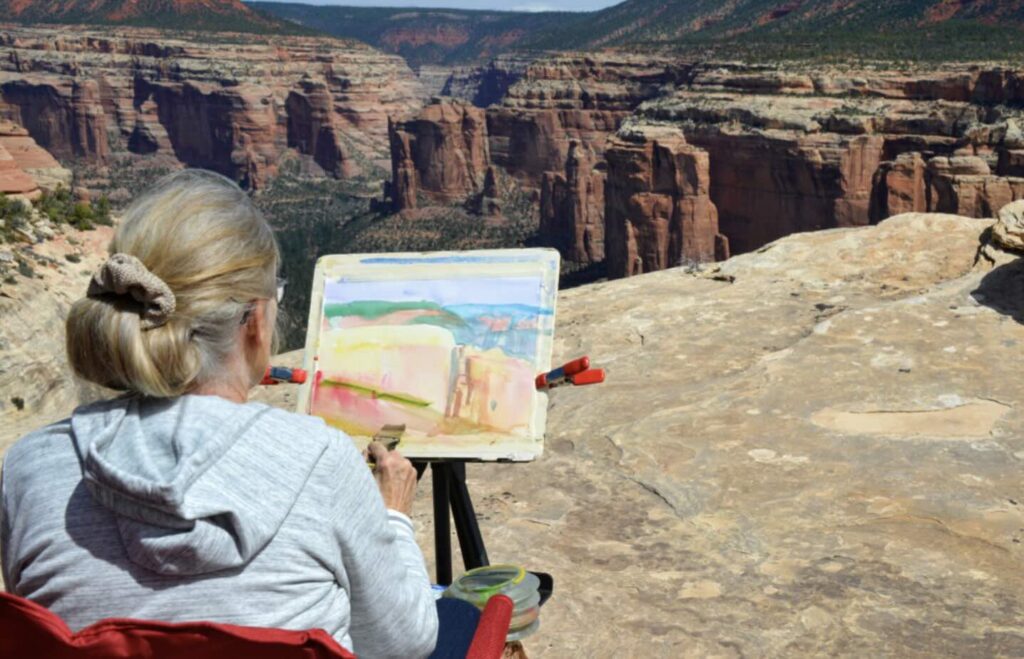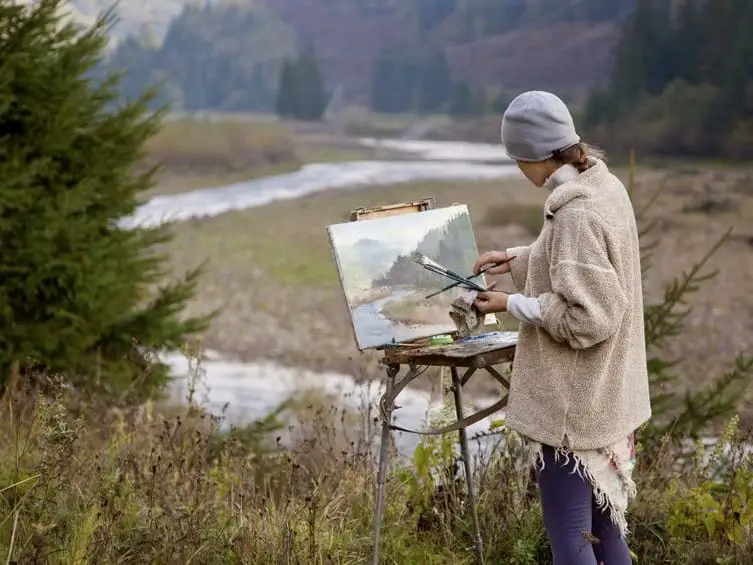There is something magical about painting outdoors. Many painters throughout history have understood this, especially the French Impressionist painters who used the phrase – “en Plein air” painting.
En Plein air means “in the open air. It refers to a style of painting outside in the natural light. This term was made famous by the French Impressionist art movement. Many of the French Impressionists painted most of their paintings outdoors. There was a lot of equipment and other challenges associated with painting everything outdoors.
Table of Contents
- What Does en Plein air painting mean?
- The History of En Plein Air Painting
- The Challenges and Equipment of en Plein Air Painting
- Frequently Asked Questions
- Related Questions

What Does en Plein air painting mean?
The French term en Plein air is a term that means “in the open air.” Essentially, this means that the artist is painting in nature and painting the subject matter in front of him or her. In other words, you paint what you see outdoors in your own environment using the natural light that nature provides.
The definition I like of en Plein air painting is:
“Of being a style of painting produced out of doors in natural light.”
free dictionary
En Plein air painters paint their subject matter outdoors. The natural light that nature provides is very important to them.
This is opposed to painters who would paint everything inside a studio. They would bring their subject matter in, set them up in the studio to paint them, and usually set the light and other things in the studio.
The History of En Plein Air Painting
Painting outdoors is not new. Paintings have been found in the caves of our cavemen and cavewomen ancestors. But what makes en Plein air painting unique is the subject matter and use of natural light.
The en Plein air movement started with the Barbizon School (an art movement towards realism), the Hudson River School (an American art movement influenced by romanticism), and the Impressionists (a French art movement that emphasized thin yet visible brush strokes and the use of light).
In 1830, Charles-Francois Daubigny and Theodore Rosseau, who were of the Barbizon School, started to pay for outdoor settings with a more accurate appearance of the outdoors. Their paintings showed various light and weather conditions.
But the group that is the most famous for using the en Plein air style of painting is the Impressionists. Impressionist artists such as Claude Monet, Pierre-August Renoir, Alfred Sisley, and Frederic Bazille started to paint most of their work outdoors.

It was from France and the Impressionist movement that the en Plein air spread worldwide. It spread to California and the American Hudson River School in New York.
Another group that believed in painting outdoors in the second half of the nineteenth century was the Macchiaioli group of Italian painters based out of Tuscany, Italy. They started to do a lot of their work outdoors to capture the natural light, colors, and shading in their paintings.
The Newlyn School in England also started to engage in en Plein air painting in the latter part of the nineteenth century. Part of what started to help them was that in 1841, paints were introduced in tubes, similar to how we purchase most of our paints today.
As you can see, besides the French Impressionists, many groups would paint outdoors. However, it was the French Impressionists who made the en Plein air movement the style of painting that it continues to be even today. When artists refer to painting outside, most use the French term “en Plein air.”
The Challenges and Equipment of en Plein Air Painting
Many may ask – well, why don’t all artists paint outdoors? There were a lot of challenges to being able to paint outdoors. Though technology has helped solve some challenges, like the invention of paints in tubes, many still plague artists today.
Even today, painting outdoors or with en Plein art can be challenging. Weather, bugs, animals, onlookers disturbing you, or just the challenge of moving all your equipment to where you want to paint. Imagine how challenging it was for the mid-nineteenth or early twentieth century artists.
Many of their challenges would have been with the equipment and supplies they could use.
Mixing paints
Before the invention of paint in tubes, many artists or their assistants would carefully ground each paint pigment and then mix the binding oil into the correct proportions to make the paint.
This could be a very messy and difficult process to do outdoors. For most artists, this was not practical and was much more accessible and better to do within the confines of their art studio.
The Invention of the Paint in Tubes
It was not until 1841 that the American portrait painter John Goffe Rand invented the paint tube. Before this time, things like pig bladders or glass syringes would have been used. Rand’s invention of the paint tube helped with the issue of mixing and carrying the paint to paint outdoors.
The tube gave the paint a longer shelf life, and since it did not leak it could be open and closed repeatedly.
Artist Pierre-Auguste Renoir understood how important this invention was to the en Plein air impressionist painters when he said
“Without paint in the tube there would have been ….nothing of what the journalists were later to call Impressionist.”
Pierre- Auguste Renoir
The Easel
Another huge challenge was the easel. Before the time of en Plein air painting, the easels were very bulky and hard to carry around. An artist would need an assistant or even a few assistants to help them carry an easel and all the supplies they needed if they wanted to go outside to paint.
For many of the impressionist artists who did not earn little money during their lifetime as Vincent Van Gogh, this would be economically impossible. This is why the invention of the pochade box easel was so important.
We are not sure who invented this pochade box easel, but we know it was invented in the 19th Century, around the time the en Plein air painting became popular with the French Impressionists. This portable easel that is so common today is also known as the “box easel” or the “French box easel. “
A really unique invention as the easels were highly portable with built-in storage compartments for the artists to put their paints, palettes, brushes, and even wet canvases.
This box easel allowed the artists to go out to paint without any help as they could carry all their supplies themselves.
Today these easels continue to be the most popular way for en Plein air artists to carry their out supplies to paint. Here are some box easels that we recommend:
- Sienna Plein Air All in One Pochade Box – We love this classic Sienna Plein Air All-in-One Pochade Box. It really has everything you need to go out and do your en Plein air painting. You can find out more by clicking here.
- Mabef Pochade Box – 13” x 16” – This is really a nice box because it also has an easel. You can find out more about it by clicking here.
- Jullian Plein Air Travel Box Table Easel – If you do not need a stand and want something that holds a large canvas up to 32″ High on the easel, this is a great portable easel. You can find out more about it by clicking here.
Canvas Size
Most en Plein air painters are limited by the canvas sizes they can bring to paint outdoors. They are limited by canvas sizes that they can safely carry back and forth to the spot they are painting. For most pochade boxes, the canvas size is usually no more than 20″ though the easel part of the box may allow you to hold a large canvas.
The canvas size is still a limitation for most people doing en Plein air painting today. Generally speaking, you can only really paint on the canvas size that you can safely carry with you back and forth to the painting location.
Paint Types and other issues.
Many of the en Plein air painters are also limited by the kind of paints they can use outdoors. For example, many acrylic paints used today may harden too fast in the warm sun, so they may not work well when painted in an outdoor setting.
Paints and palettes could get bugs, or animals could disturb the paintings or even your palette. There could be unwanted onlookers disturbing or wanting to touch your painting.
A sudden wind could blow the painting and all the supplies away. Or the painting and the paints could get almost destroyed by a sudden change in the weather as a thunderstorm.

Many French Impressionists would do most of their work outdoors under a large white umbrella. The large white umbrellas helped to diffuse or soften the light. I am sure the umbrella also helped protect them from natural elements such as the harsh summer sun or a sudden rainstorm.
En Plein air painting, or painting outdoors in the natural sunlight, is a painting technique that has lasted for centuries.
The reason is that for some subject matters, nothing can beat being outdoors to paint what you see in nature – right in front of your eyes. This is what the French Impressionist masters taught us when they painted their paintings outdoors.
Frequently Asked Questions
What is en Plein air painting?
En Plein air painting is a technique that involves creating artwork outdoors, directly in the natural environment. The term, derived from French, translates to “in the open air.” It gained prominence during the French Impressionist movement.
Why is en Plein air painting considered special?
En Plein air painting is cherished for its ability to capture the essence of a scene in natural light. The technique allows artists to observe and respond to changing atmospheric conditions, resulting in a unique and authentic representation of the subject.
What equipment is typically used for en Plein air painting?
Essential equipment includes portable easels, a variety of brushes, a palette, paints, and a lightweight palette knife. Artists may also use collapsible chairs and portable storage solutions for their supplies.
How does en Plein air painting differ from studio painting?
En Plein air painting involves working outdoors, allowing artists to directly interact with their surroundings. Studio painting, on the other hand, is done indoors and often relies on reference materials such as photographs.
What are the key challenges of en Plein air painting?
Challenges include changing light conditions, weather fluctuations, and the need for quick decision-making. Artists must adapt to these challenges while maintaining focus on their creative process.
Do I need formal art training to try en Plein air painting?
While formal training can be beneficial, en Plein air painting is accessible to artists of all skill levels. Beginners can start with basic equipment and gradually refine their techniques through practice and experience.
How do artists choose their en Plein air painting locations?
Artists often seek visually appealing scenes with interesting compositions, lighting, and atmospheric conditions. The choice of location can greatly influence the mood and style of the artwork.
Can en Plein air painting be done in any weather?
En Plein air painting is versatile and can be done in various weather conditions, but artists should be prepared for the challenges posed by wind, rain, or extreme temperatures. Some artists embrace the unpredictability of weather in their work.
Is there a specific time of day that’s best for en Plein air painting?
Many artists prefer painting during the “golden hours” of early morning or late afternoon when the sunlight creates warm and soft tones. However, artists may choose any time that suits their preference and the desired atmosphere of their painting.
How has en Plein air painting influenced art movements beyond Impressionism?
En Plein air painting has left a lasting impact on various art movements, inspiring artists to engage with nature directly. Post-Impressionists, Realists, and contemporary artists continue to explore the technique, adapting it to their unique styles and expressions.
Anita Louise Art is dedicated to art education, great artists, and inspiring others to find and create their art. We love art that uplifts and inspires. #ArtToMakeYouSmile! #ArtToMakeYouHappy!
If you are interested in seeing any of my art, you can find out more by clicking here. If you are interested in what inspires me and my paintings, you can discover more by clicking here.
We have a free newsletter and would love you to be part of our community; you can subscribe to the newsletter by clicking here. If you have any questions, I would be happy to talk to you at any time. You can reach me, Anita, by clicking here.
Subscribe to our Anita Louise Art YouTube Channel filled with great videos and information by clicking here.
Join us for our podcast “5 Minutes With Art.” Spend just 5 minutes a week with us to discover and learn about great art and artists. You can find out more about our podcast by clicking here.
Related Questions
Why Was Impressionism Art at First Rejected?
During the era of impressionism art, fine art oil painting was an extremely important addition to the interior design of a home, especially for the affluent and the increasing arrival of the middle classes. For these art patrons, there were only some very specific styles of art that they considered acceptable for them to use for the interior design of their home and impressionism art did not fit into any of these culturally acceptable fine art categories.
To find out more about this, you can read our blog on Why Was Impressionism Art at First Rejected? by clicking here.
Who Were Some of the Women Impressionist Artists?
When we think of Impressionist art, most people think of all the famous male artists. But many women were considered significant women impressionist artists. The seven significant women of impressionist painters are Berthe Morisot, Mary Stevenson Cassatt, Marie Bracquemond, Louise Catherine Breslau, Eva Gonzales, and Lilla Cabot Perry. Each of these women in their own unique ways, contributed to the impressionism art movement.
To find out more you can read our blog on 7 Women Impressionist Artists, To Admire, Know and Remember by clicking here.


